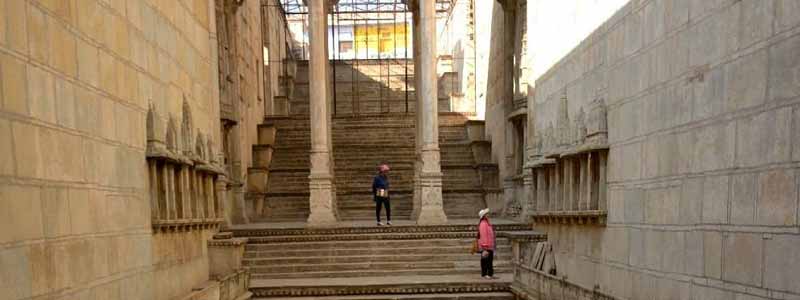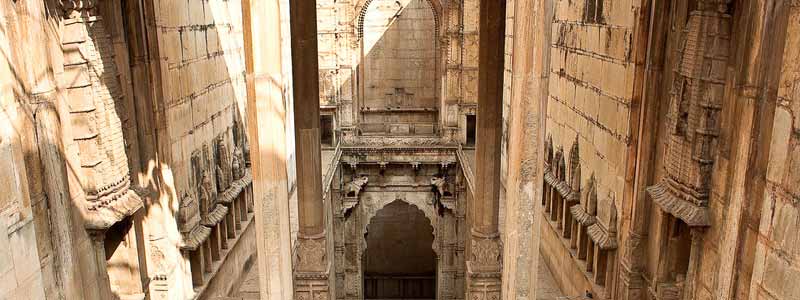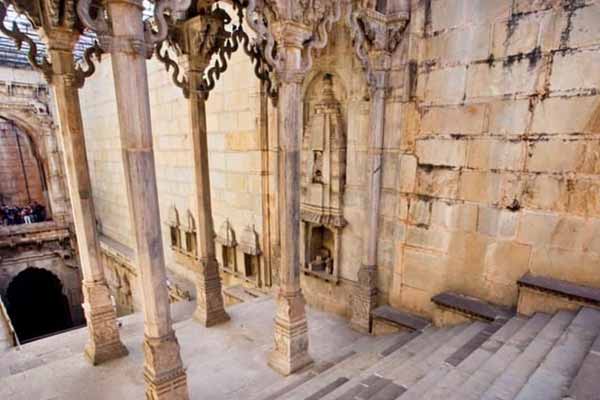Raniji ki Baori Bundi also “Queen’s stepwell” is a noted stepwell situated in Bundi town in Rajasthan state in India. It was built in 1699 by Rani Nathavati Ji (Solanki) who was the younger queen of the ruling Rao Raja Anirudh Singh of Bundi. It is a 46 meter deep stepped well with some superb carvings on its pillars and a high arched gate. It is a multistoreyed structure with places of worship on each floor.
The step well has a narrow entrance marked by four pillars. Stone elephant statues that face each other stand in the corners. Ogee brackets decorate all the archways of 46 m deep Raniji ki Baori, which is reputedly the largest Baori of Bundi. Baoris were significant social constructions in the medieval Bundi since they acted as assembly areas for the townsfolk. Raniji ki Baori Bundi has superb carvings on its pillars and a high arched gate.

History Of Raniji Ki Baori Bundi Rajasthan
Raniji’s BAORI was constructed in 1699 on the orders of Rani Nathavatji who was the younger queen of the ruling Rao Raja Anirudh Singh of Bundi. This Stepwell is situated in the small garden of Bundi. And the depth of this BAORI is about 46 meters Rajasthan Budget tours.
Raniji ki Baori Bundi is well-known for its intricately carved butt and shape. A grand entrance has also been constructed to enter this BAORI. Curved pillars and wide staircases add to the beauty of Raniji’s BAORI. Raniji’s BAORI is an all-around and beautiful garden.
Presently, the task of Rani ji’s BAORI protection is with the Archaeological Survey of India Department. Bundi district of Rajasthan is a historical and cultural city that is known worldwide for its special forts, palaces, and Raniji ki Baori Bundi.
For the first time, the Postal Department has issued postage stamp sheets on the ancient steps of the country. These include Ranji’s Bawdi of Bundi, which is counted among the main BAORI of Asia. Their sheets are released on 29 December by the postal department of New Delhi.

Raniji ki Baori Structure
Raniji ki Baori is a three storey stepwell and has two fantastic well-arched gates with great artwork done on the pillars and statues of Elephants made up of white marble (not too white) on the top of all columns. The last (3rd) gate of the stepwell is a beautiful one as it has the sculptures of elephants on all corner and it’s a delight to watch.
The entrance of the baori is on the 2nd floor, as the local authority has closed the entry from the 1st (or ground floor). Might be to stop pigeons entering the stepwell as they have made of mess of almost every stepwell of India. I saw that at Chand Baori in Abhaneri, the rooms were stinking of pigeon shit. At Bundi, they (local authority) have completely covered the baori with an iron sheet, (more like a transparent one) which is a smart move to keep the site clean.
Best Time to Visit:
The best time to visit Bundi is winters from October to March when the weather is quite enchanting and enlivening. The temperature during these months ranges from 5°C – 30°C.
How to Reach:
Raniji ki Baori Bundi is located at a distance of 35 Km from Kota Station in Bundi. The nearest airport is the Jaipur Airway, which is at a distance of 206 km from Bundi. It is well connected by road with the other important places in Rajastha. The entry fee is very nominal and extra Rs. 100 needs to be paid if one wishes to carry a camera in the premises.
Tourists can spend some peaceful time savoring the history of this baori. There are stalls outside the stepped well, where one can taste local Rajasthani snacks.
